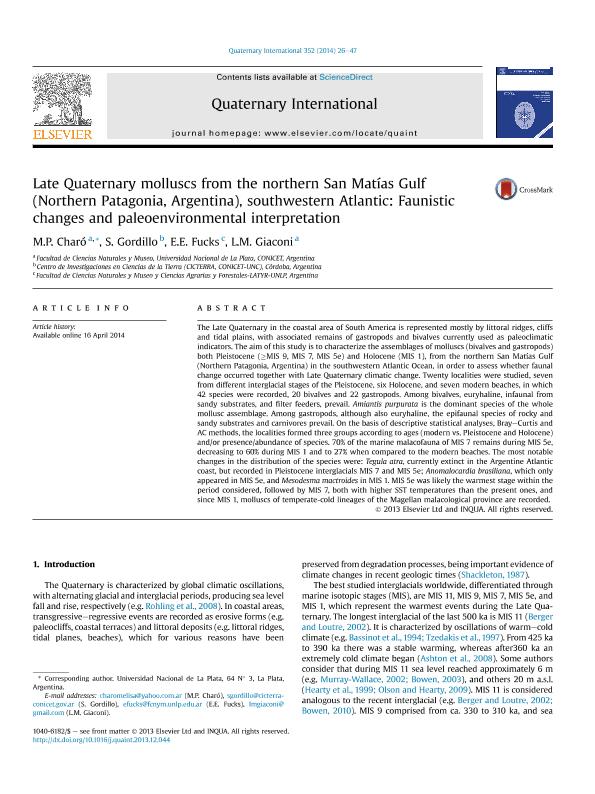Mostrar el registro sencillo del ítem
dc.contributor.author
Charo, Melisa Paola

dc.contributor.author
Gordillo, Sandra

dc.contributor.author
Fucks, Enrique Eduardo

dc.contributor.author
Giaconi, Luis Mario

dc.date.available
2019-07-04T17:44:28Z
dc.date.issued
2014-03
dc.identifier.citation
Charo, Melisa Paola; Gordillo, Sandra; Fucks, Enrique Eduardo; Giaconi, Luis Mario; Late Quaternary molluscs from the northern San Matías Gulf (Northern Patagonia, Argentina), southwestern Atlantic: Faunistic changes and paleoenvironmental interpretation; Pergamon-Elsevier Science Ltd; Quaternary International; 352; 3-2014; 26-47
dc.identifier.issn
1040-6182
dc.identifier.uri
http://hdl.handle.net/11336/79144
dc.description.abstract
The Late Quaternary in the coastal area of South America is represented mostly by littoral ridges, cliffs and tidal plains, with associated remains of gastropods and bivalves currently used as paleoclimatic indicators. The aim of this study is to characterize the assemblages of molluscs (bivalves and gastropods) both Pleistocene (≥MIS 9, MIS 7, MIS 5e) and Holocene (MIS 1), from the northern San Matías Gulf (Northern Patagonia, Argentina) in the southwestern Atlantic Ocean, in order to assess whether faunal change occurred together with Late Quaternary climatic change. Twenty localities were studied, seven from different interglacial stages of the Pleistocene, six Holocene, and seven modern beaches, in which 42 species were recorded, 20 bivalves and 22 gastropods. Among bivalves, euryhaline, infaunal from sandy substrates, and filter feeders, prevail. Amiantis purpurata is the dominant species of the whole mollusc assemblage. Among gastropods, although also euryhaline, the epifaunal species of rocky and sandy substrates and carnivores prevail. On the basis of descriptive statistical analyses, Bray-Curtis and AC methods, the localities formed three groups according to ages (modern vs. Pleistocene and Holocene) and/or presence/abundance of species. 70% of the marine malacofauna of MIS 7 remains during MIS 5e, decreasing to 60% during MIS 1 and to 27% when compared to the modern beaches. The most notable changes in the distribution of the species were: Tegula atra, currently extinct in the Argentine Atlantic coast, but recorded in Pleistocene interglacials MIS 7 and MIS 5e; Anomalocardia brasiliana, which only appeared in MIS 5e, and Mesodesma mactroides in MIS 1. MIS 5e was likely the warmest stage within the period considered, followed by MIS 7, both with higher SST temperatures than the present ones, and since MIS 1, molluscs of temperate-cold lineages of the Magellan malacological province are recorded.
dc.format
application/pdf
dc.language.iso
eng
dc.publisher
Pergamon-Elsevier Science Ltd

dc.rights
info:eu-repo/semantics/openAccess
dc.rights
Atribución-NoComercial-CompartirIgual 2.5 Argentina (CC BY-NC-SA 2.5 AR)
dc.rights.uri
https://creativecommons.org/licenses/by-nc-sa/2.5/ar/
dc.subject
Quaternary
dc.subject
Mollusck
dc.subject
Gulf of San Matias
dc.subject
Palaeoecology
dc.subject.classification
Meteorología y Ciencias Atmosféricas

dc.subject.classification
Ciencias de la Tierra y relacionadas con el Medio Ambiente

dc.subject.classification
CIENCIAS NATURALES Y EXACTAS

dc.title
Late Quaternary molluscs from the northern San Matías Gulf (Northern Patagonia, Argentina), southwestern Atlantic: Faunistic changes and paleoenvironmental interpretation
dc.type
info:eu-repo/semantics/article
dc.type
info:ar-repo/semantics/artículo
dc.type
info:eu-repo/semantics/publishedVersion
dc.date.updated
2019-06-14T18:37:10Z
dc.journal.volume
352
dc.journal.pagination
26-47
dc.journal.pais
Estados Unidos

dc.description.fil
Fil: Charo, Melisa Paola. Consejo Nacional de Investigaciones Científicas y Técnicas. Centro Científico Tecnológico Conicet - La Plata; Argentina. Universidad Nacional de La Plata. Facultad de Ciencias Naturales y Museo; Argentina
dc.description.fil
Fil: Gordillo, Sandra. Consejo Nacional de Investigaciones Científicas y Técnicas. Centro Científico Tecnológico Conicet - Córdoba. Centro de Investigaciones en Ciencias de la Tierra. Universidad Nacional de Córdoba. Facultad de Ciencias Exactas Físicas y Naturales. Centro de Investigaciones en Ciencias de la Tierra; Argentina
dc.description.fil
Fil: Fucks, Enrique Eduardo. Universidad Nacional de La Plata. Facultad de Ciencias Naturales y Museo; Argentina. Universidad Nacional de La Plata. Facultad de Ciencias Agrarias y Forestales; Argentina
dc.description.fil
Fil: Giaconi, Luis Mario. Consejo Nacional de Investigaciones Científicas y Técnicas. Centro Científico Tecnológico Conicet - La Plata; Argentina. Universidad Nacional de La Plata. Facultad de Ciencias Naturales y Museo; Argentina
dc.journal.title
Quaternary International

dc.relation.alternativeid
info:eu-repo/semantics/altIdentifier/doi/http://dx.doi.org/10.1016/j.quaint.2013.12.044
dc.relation.alternativeid
info:eu-repo/semantics/altIdentifier/url/https://www.sciencedirect.com/science/article/pii/S1040618213009786
Archivos asociados
